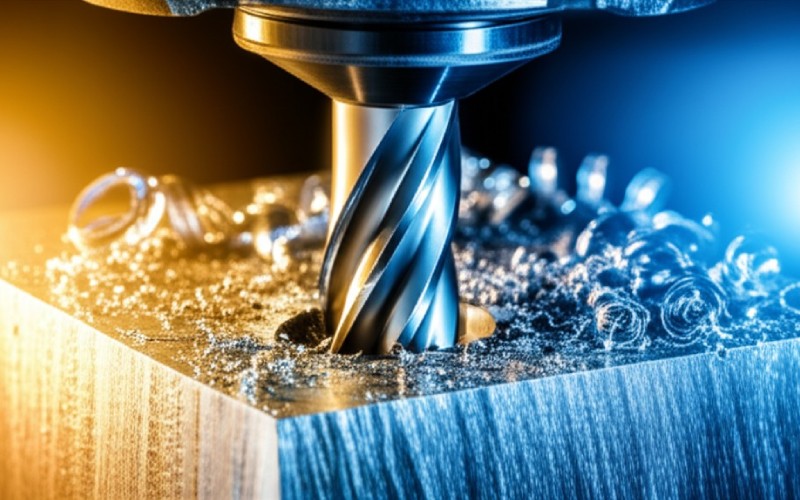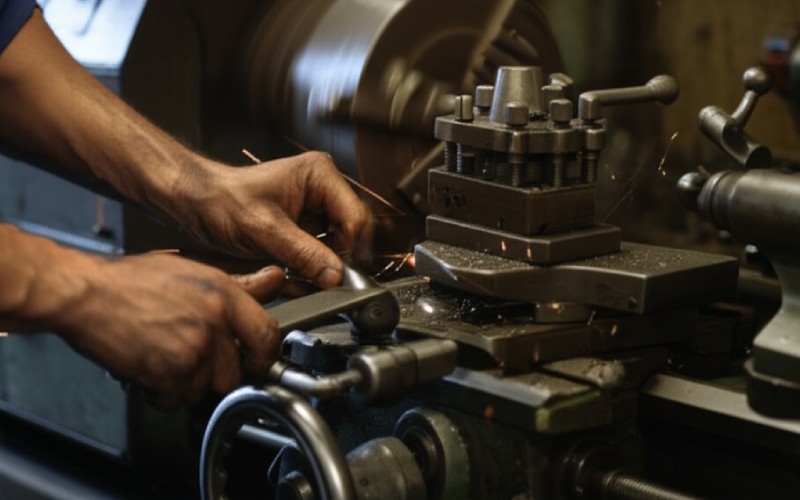Lad Istar hjælpe dig med at komme i gang med dit projekt med vores erfaring og knowhow!
Upload dine designfiler og produktionskrav, så vender vi tilbage til dig inden for 30 minutter!

Choosing between a CNC machine and a manual machine can be a complex decision. This choice affects your budget, timeline, and the overall quality of your parts. In this article, we’ll look at CNC-bearbejdning vs manual machining in simple terms. By the end, you’ll know exactly how to choose the right machining process for your project and your wallet. This is a detailed comparison to help you make a smart decision.
So, what is a manual machine? Think of it as hands-on work. A manual machine is a tool that is controlled directly by a person, a skilled machinist. This machinist uses wheels, levers, and dials to guide a cutting tool. They carefully remove material from a piece of metal or plastic to shape it. The machinist must be very skilled. They rely on their eyes, their hands, and their experience to make each cut. Every part made on a manual machine is a result of the operator’s direct actions.
The process on a manual machine is very deliberate. The operator first plans the cuts. Then, they set up the piece of material on the machine. Using manual controls, they move the cutting tool. They might use a manual lathe to turn a round part or a manual mill to cut a flat surface. This type of machine requires constant attention. The machinist checks their work often with measuring tools to ensure accuracy. Because manual machines require so much human skill, the quality of the part depends heavily on the person operating the machine. This is why a good machinist is worth their weight in gold.

Now, let’s talk about the CNC machine. CNC stands for Computer Numerical Control. That sounds fancy, but the idea is simple. Instead of a person turning the wheels, a computer tells the machine what to do. A CNC machine reads a special set of instructions from a computer file. This file tells the cutting tool exactly where to move, how fast to go, and how deep to cut. This process is called computer numerical control machining. It is a key part of modern manufacturing.
The real magic of a CNC machine is the automation. Once the program is loaded and the machine setup is done, the machine can work on its own with minimal human intervention. The computer software dictates the movement of the machine’s axes and spindle. This allows a CNC machine to perform complex tasks over and over again with the same result. An operator is still needed to oversee the machine, load material, and check the first part. But the CNC machine does the heavy lifting of the actual cutting. This is the core of what makes a CNC machine so powerful.
So, what is the main difference between CNC and manual? The biggest difference is control. On a manual machine, an operator is in direct, constant control. They are the brain of the operation. On a CNC machine, a computer program is in control. The CNC machinist prepares the program and sets up the machine, but the computer executes the cuts. This is the key distinction between CNC and manual machining.
This one big difference leads to many others. A manual machine is flexible for one-off jobs. A machinist can quickly make a simple part without needing to write a computer program. A CNC machine, on the other hand, shines when you need to make many identical parts. Once the program is perfect, a CNC machine can produce parts all day with amazing consistency. This is why it’s important to know the differences between the two machining methods to pick the right one for your specific needs. Understanding the differences between CNC vs manual machining is crucial.
When we talk about precision, we’re talking about making parts that are exactly the right size and shape. So, how do CNC and manual machines compare in precision? A CNC machine almost always wins here. Because it’s run by a computer, a CNC machine can make cuts with incredible accuracy, often to within a thousandth of an inch. This high precision is repeatable. The 100th part will have the same high precision as the first part.
A skilled operator on a manual machine can also achieve high precision. A master machinist is an artist. However, it’s much harder to maintain that same level of precision over and over. Every person has small variations in how they work. This is just human nature. A manual machine might be great for a single prototype, but for high-volume production where every part must be identical, the precision of CNC is a huge advantage. Manual machines lack the built-in repeatability that a CNC machine offers.
Let’s look at two of the most common machine tools: the mill and the lathe. A mill uses a spinning cutting tool to shape a part. A lathe spins the part itself against a stationary cutting tool. You can find both a manual machine version and a CNC machine version of each. A manual mill requires an operator to move the table on X and Y axes, and the spindle on the Z axis. A manual lathe needs a machinist to control the cutting tool’s movement along the spinning workpiece.
CNC mills and CNC lathes do the same jobs, but automatically. A CNC mill can move in three, four, or even five axes at once to create very complex shapes. A CNC machine like this can perform complex milling operations that would be difficult or impossible on a manual milling machine. Similarly, CNC lathes can create intricate curves and features with perfect precision. The CNC machine version of a mill or lathe simply offers more capability and higher precision compared to manual machines.
This is a great question. Can a manual machine handle a part with lots of curves and weird angles? The answer is yes, but with great difficulty. A very talented machinist can create some amazing parts on a manual mill or manual lathe. They use special tools, jigs, and lots of careful setups. However, it takes a huge amount of time and skill. The geometry of the part is limited by what the operator can physically do.
This is where a CNC machine shines. For parts with complex shapes or intricate geometry, a CNC machine is the best choice. A programmer can design the part using computer software (like CAD/CAM, or computer-aided manufacturing software). This design is then turned into code that the CNC machine reads. The machine can then cut the complex shapes perfectly, every time. Trying to make the same part on a manual machine would take much longer, and the cost may be much higher due to the labor involved.
Let’s talk money. Many people think a manual machine is cheaper. And for the initial purchase, they are right. The upfront investment in CNC machines is higher than for a manual machine. However, the true cost difference between CNC and manual is more than just the price tag. You have to think about the total machining costs over the life of a project.
For single, simple parts or a one-off prototype, a manual machine can have a lower cost. There’s no programming time. A machinist can just get to work. But as soon as you need more than a few parts, or if the part is complex, the CNC machine becomes cheaper. The production speed of a CNC machine is much faster, so the cost per part drops quickly. Also, a CNC machine can run with less direct supervision, which lowers labor costs. You need to look beyond the initial investment in CNC machines and consider the long-term savings. Budget constraints might make you look at a manual machine, but a CNC machine is often a better investment.
If you need parts fast, which machine should you choose? For a single, simple prototype, a manual machine can sometimes be faster. A machinist can walk up to the manual machine and start cutting right away. There are no programming skills needed, and there is no time spent writing code. The turnaround for one simple piece can be very quick.
However, for anything more than that, a CNC machine is the winner in production speed. Once the program is proven, a CNC machine can produce parts much faster than any human operator on a manual machine. This is especially true for high-volume production runs. A CNC machine can run day and night, leading to much shorter turnaround times for larger orders. If you need 100 or 1,000 identical parts, the benefits of CNC machining and its speed are undeniable. Manual machining may not be able to keep up.

The role of the person running the machine is very different for a manual machine versus a CNC machine. To run a manual machine, you need a highly skilled operator. This machinist must have years of experience. They need a deep understanding of speeds, feeds, materials, and how to perform machine operations safely and accurately. These manual machinists are true craftsmen. Manual processes rely on manual skill.
On a CNC machine, the operator’s role changes. They are still very important! A CNC machinist needs to understand the machine, read blueprints, and use precision measuring tools. They are responsible for the machine setup, loading the program, and making sure the first part is perfect. However, they don’t need the same hands-on, muscle-memory skills as a manual machinist. Instead, they need a good grasp of CNC technology and sometimes programming skills. Both roles require skill, but the skills themselves are different.
So, after comparing CNC and manual, how do you make a choice? It comes down to four things: complexity, quantity, precision, and cost. If you need a simple, one-off prototype and have a skilled operator, a manual machine is a great choice. Many people prefer manual machining for quick repairs or simple jigs. Manual machining still has its place in the industry.
However, if your project involves complex shapes, requires high precision, or you need a large number of identical parts, the CNC machine is your answer. The investment in CNC pays off with speed, repeatability, and accuracy that manual methods can’t match. For most modern manufacturing solutions, a CNC machine is the standard. If you are working with CNC machining partners for custom CNC parts, they will likely use various machine types, but the core work for production will be on a CNC machine. Knowing the differences between CNC and manual helps you have a smarter conversation with your CNC machining services provider.